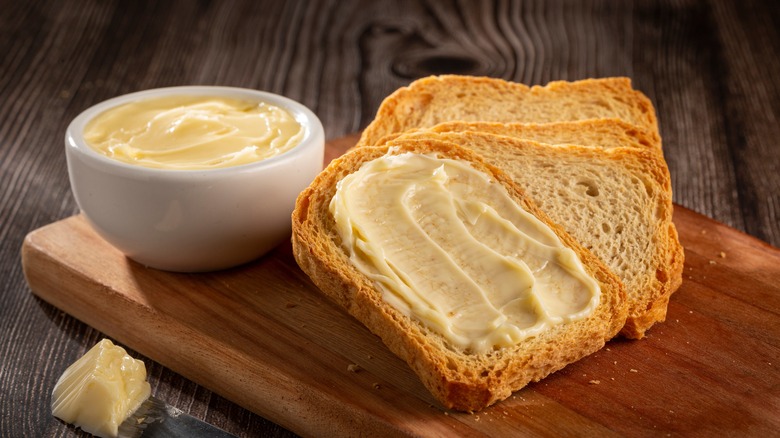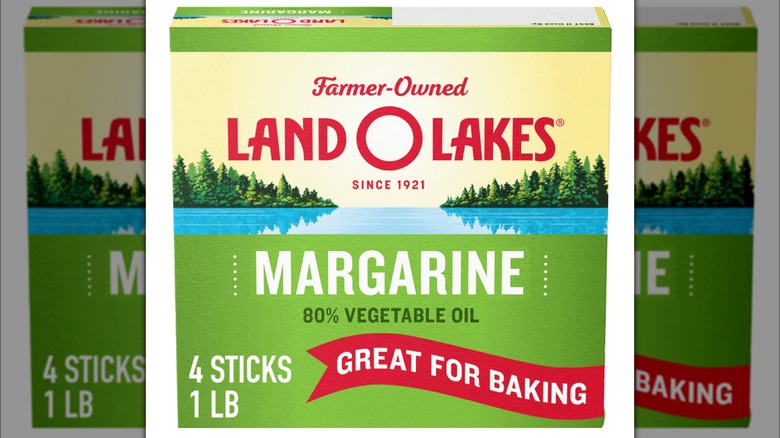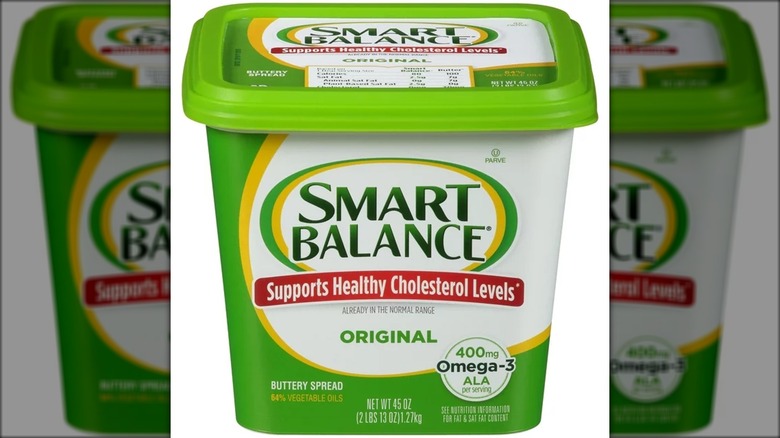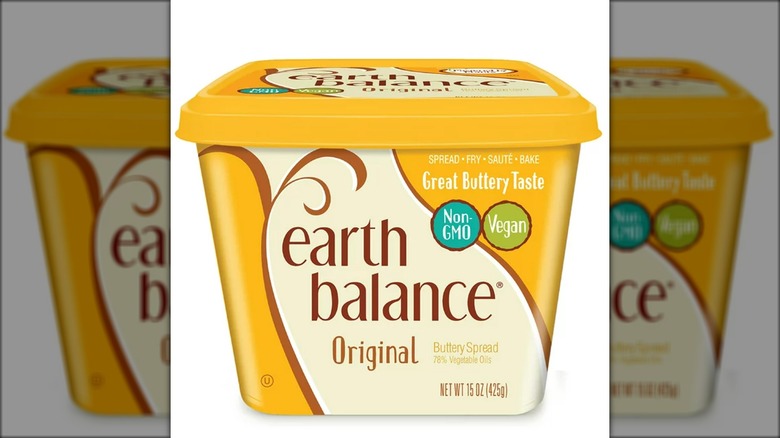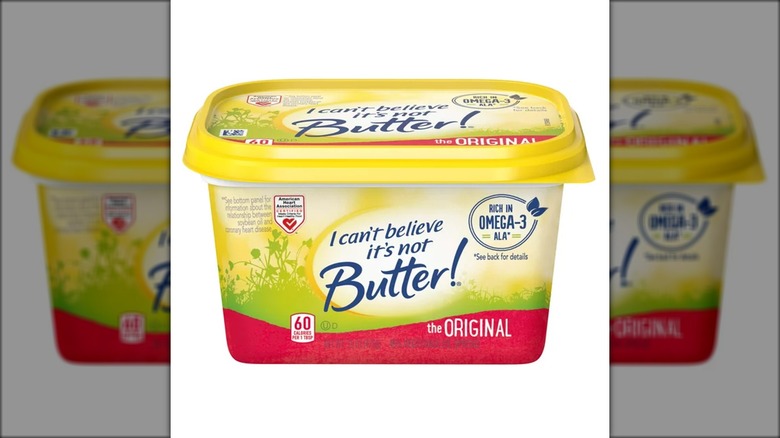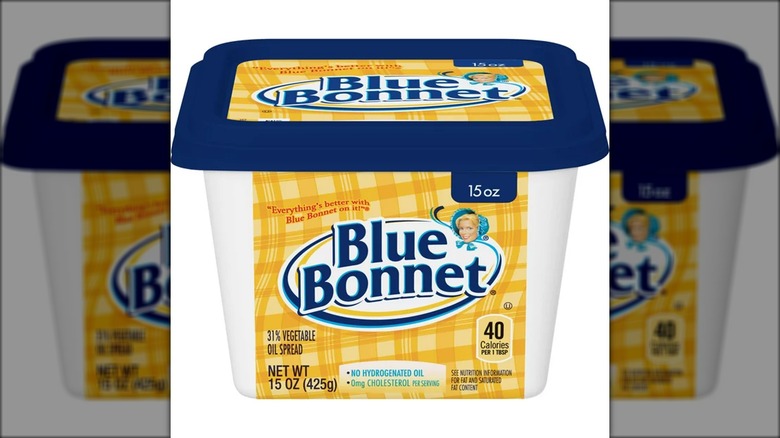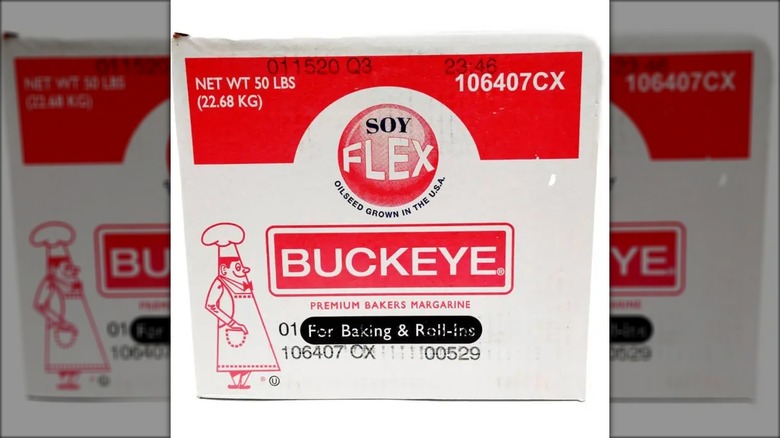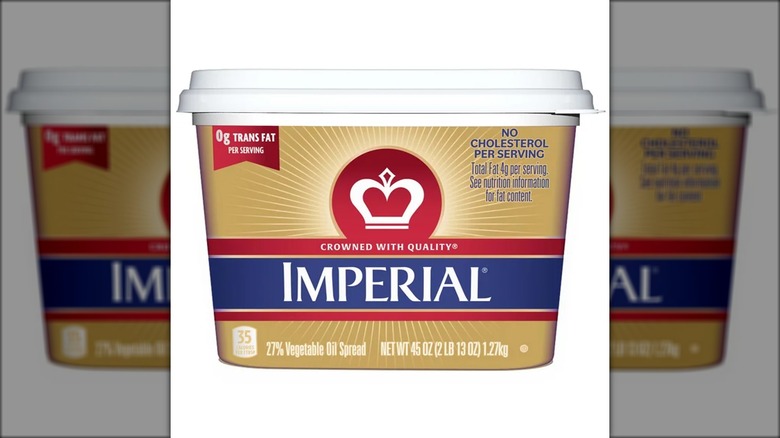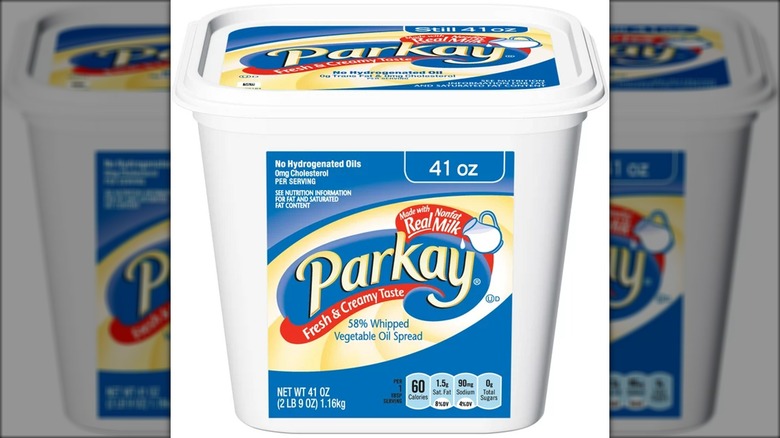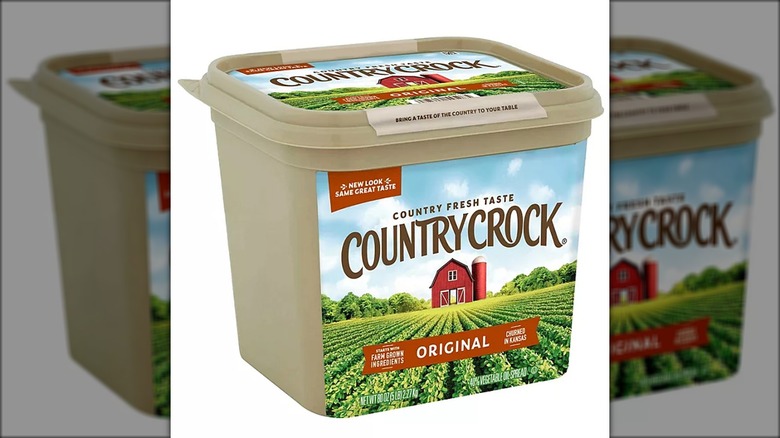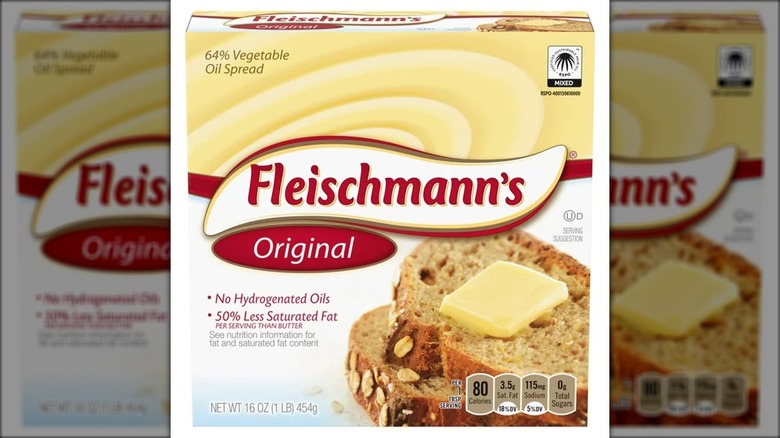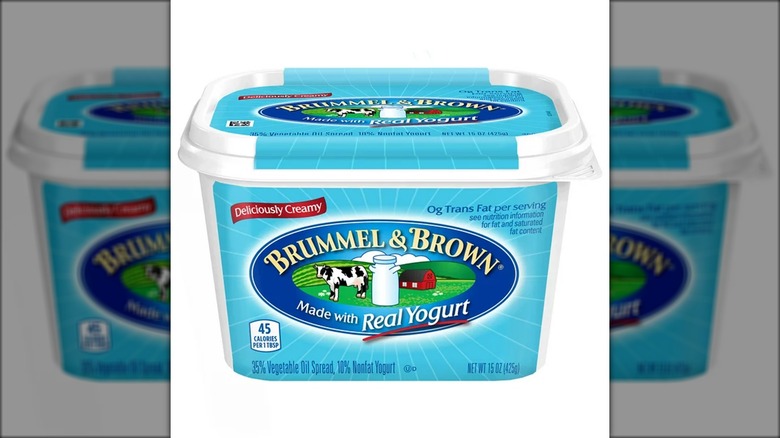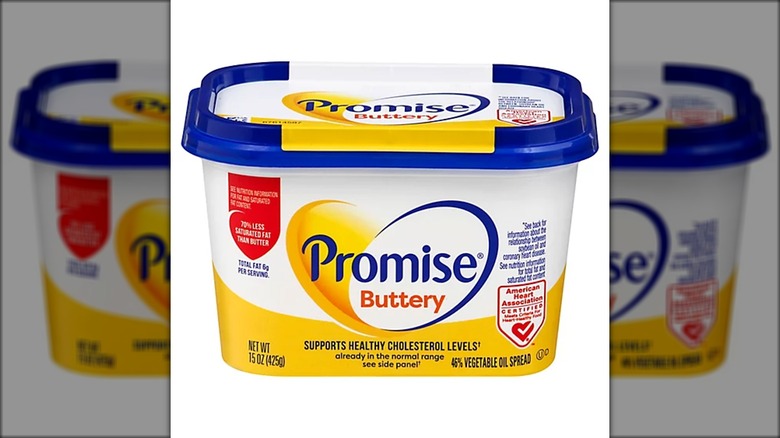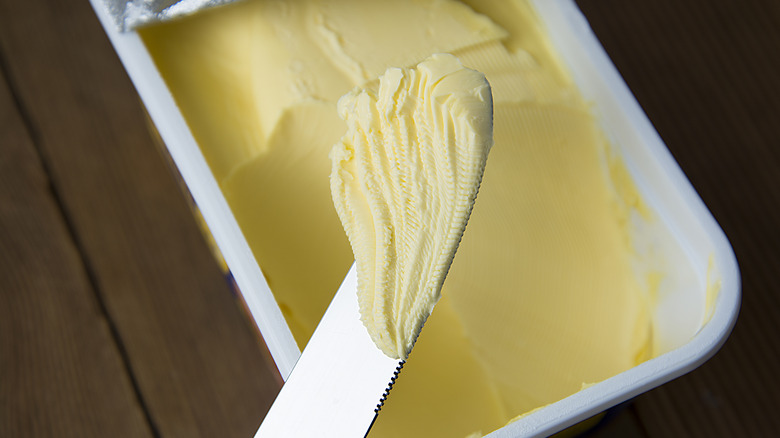Margarine Brands Ranked From Worst To Best, According To Customers And Nutritional Content
We may receive a commission on purchases made from links.
If you've found yourself looking for a margarine brand to replace butter, some certainly rank better and worse than others. The ingredient lists can be daunting, and it can take a lot of time to pour through reviews and nutrition labels to figure out which ones are best and which you shouldn't even bother trying. However, we've done it so that you don't have to.
Not too many imitation butters call themselves "margarine" these days either for legal or marketing purposes. After all, margarine has a reputation for containing chemicals, hydrogenated oils, and bad fats. Even though many margarines have adjusted their ingredients, the stigma remains. These days, you'll mostly find "spreads" and "buttery spreads." But, do they actually taste good, and how healthy are they?
Many margarines and buttery spreads have recently made changes that have left long-time fans unhappy. None have cholesterol or trans fats anymore since trans fats were banned in 2020. Many brands' flavor change complaints started more recently. While the ingredient lists have fewer highly processed ingredients and hydrogenated oils than they used to, they're still not perfect. Even though all have less saturated fat than butter, there are still some health and ethical concerns no matter which margarine you choose. For example, they all contain a mix of questionable oils and all have saturated fats. However, we've found margarine brands that are clearly better and worse than others based on what customers think as well as their ingredients and nutritional content.
12. Land O Lakes
Land O Lakes is one of the few imitation butters that still uses the name "margarine" on its packaging. Past fans complain that the recipe has changed, that it doesn't taste as good as it once did, and that it's now more hard than creamy. Descriptions of the new flavor say it's fishy or funky and that it's not as much like real butter. It seems that Land O Lakes margarine is only available regionally or in large quantities.
The ingredient list is intriguing since it contains buttermilk. It also contains less-than-desirable soybean oil, palm oil, and palm kernel oil like so many other margarines. Soybean oil is known to have negative health effects when consumed often. Although palm oil is associated with health benefits, both palm oil and palm kernel come with concerns related to saturated fat content and contributing to deforestation. However, this margarine does provide 10% of the Vitamin A you need for the day since it's real margarine.
Land O Lakes Margarine has more calories, fat, and saturated fat than most margarines on our list. This, along with its poor reviews, is why it's at the bottom of our list. Both versions have as much fat (11 grams) and calories (100) as butter. You'll find that the tub version has less saturated fat than the stick version (3 grams versus a whopping 5 grams). Meanwhile, the sodium ranges between 100 and 105 milligrams per serving.
11. Smart Balance
Smart Balance changed its oil content and had lots of unhappy customers before switching back to its old recipe in 2022. Unfortunately, it changed to formula again soon after to have 64% oil, leading to nothing but bad reviews and discontent. Not only does it no longer have the texture of butter, but it's crumbly and doesn't taste as much like butter as it once did. So, customers are abandoning it.
This spread looks fine at first glance since it uses olive oil and flax oil among its ingredients. However, it also has a couple of less desirable oils: canola oil and palm oil. The better oils would balance out the other oils to make it a little more desirable if the texture and flavor hadn't changed so much.
The nutritional content is relatively fine. There are only 80 calories per serving, 9 grams of fat, and 90 milligrams of sodium. Impressively, only 2.5 of those 9 fat grams are saturated, and it contains 20% of the daily value of Vitamin D and 10% of Vitamin A. So, it looks good on paper even if the flavor and texture don't follow, which lands it second to last in our ranking.
10. Earth Balance
Earth Balance is another buttery spread that has suffered from an outpouring of negative reviews in recent years. Customers who had been fans for decades have not been happy after its recipe change in 2023. Not only has the flavor changed, but it leaves a lot of people thinking they've gotten a product that has gone bad. The sentiments seem to be the same for the original and the soy-free variety. A Redditor said, "It was my favorite, but every batch I have had the past couple years just tastes rancid. It ruined my pie crust on Thanksgiving."
Earth Balance uses a mix of both good oils like olive, flax, and palm fruit oil along with some oils that have reputations for not being as healthy in large quantities like canola oil and safflower oil (in the non-soy version) or soybean oil (in the original version). Plus, palm oil has a reputation for not being ethically sourced. However, using a non-dairy version of lactic acid makes Earth Balance vegan.
Earth Balance has one of the highest calorie and fat counts on our list at 100 calories and 11 grams of fat per serving (the same as butter). On a positive note, the fat content breaks down to only 3 grams of saturated fat. There's also a nutritional difference in the sodium content, with the non-soy version having more sodium than the original (110 versus 105 grams).
9. I Can't Believe It's Not Butter!
I Can't Believe It's Not Butter! made a huge change in 2014 to create a spread with simpler ingredients its customers could recognize. Unfortunately, it made another change in 2023 that many (but not all) long-time customers don't like. A Walmart reviewer said, "Don't know what you have done to the recipe but I have used this product for years and I'll now be changing. The taste is horrible and it no longer melts in a pot or on warm food products." So, fewer people are happy buying this brand now.
There are also a couple of negatives when it comes to the ingredients in this spread. The current ingredient list includes palm and palm kernel oil, which some people don't buy for ethical purposes. Plus, it includes soybean oil, which isn't healthy if you consume a lot of it. In addition to soy, it contains dairy products, so it's not vegan. However, the flavor is natural, and vinegar is a more natural preservative. So, it does have a few things going for it in the ingredient department.
Each 1-tablespoon serving is only 60 calories, so it does have something going for it. It also only has 6 grams of fat, with only 2 grams being saturated. The sodium isn't too bad at 90 milligrams per serving. A serving of Can't Believe It's Not Butter! also provides 10% of the Vitamin A you need each day.
8. Blue Bonnet
In recent years, many people have switched to Blue Bonnet as a result of recipe changes for their normal margarine. Customers find it good for spreading. However, there are some complaints about the water content making it splatter if you try using it for cooking. And while some think it tastes buttery, others don't.
Blue Bonnet has more questionable ingredients than most margarines. Not only does it contain soybean and palm-based oils, but the original tub, stick, and Calcium Plus Vitamin D varieties all contain questionable sodium benzoate. The tub version contains highly processed maltodextrin. Both the tub and calcium versions contain calcium disodium EDTA, which is somewhat concerning but safe in low amounts. The calcium version also contains corn oil, which tends to be highly refined and with a few health concerns. The stick version also contains dairy products.
If you don't count the sodium content, the nutrition stats are impressive for these butter alternatives. They all have between 40 and 60 calories, with the tub version having the least. The fat content ranges from 4.5 grams to 7 grams, with the tub version having the least and the stick version having the most. The saturated fat content only ranges from one to 2.5 grams, which isn't bad. The sodium level is higher than most at 130 to 135 milligrams per serving. With the calcium-added version, you get 4% of Vitamin A, 10% of calcium, and 20% of Vitamin D you need for the day.
7. Buckeye Soy Flex
Buckeye Soy Flex Premium Bakers Margarine is a product that is only available in a 50-pound container. So, most people use it in a commercial setting or wish they could find it in smaller quantities to use at home. Unfortunately for its fans, it can be difficult to find anywhere but online. However, its customers seem to be mainly happy with it.
While Buckeye Soy Flex Margarine does contain 15% of the amount of Vitamin A you need for the day, it has a few ingredients that can be considered negative like soybean oil. It also contains hydrogenated soybean oil, which can raise cholesterol. Its preservative, sodium benzoate, has potential health risks. While it contains a lot of iffy ingredients, it is non-dairy, making it safe for those with dairy allergies. A 1-tablespoon serving of Buckey Soy Flex Margarine has 100 calories and 11 grams of fat, just like butter. While five of those fat grams are saturated fats, it's the only one on our list that contains no sodium, making it good to use as you would unsalted butter.
6. Imperial
Imperial has its fans, but it's not perfect. One thing Imperial buyers seem to like is that it doesn't have as much water, so it doesn't leave toast soggy when it melts like some other brands. Another bonus is that you can use the stick version just like butter in recipes. While most customers tend to like its flavor, some differ in opinions about whether it tastes more like butter or more like oil or chemicals. Both the version that comes in a tub and the one in stick form include soybean and palm kernel oil. However, those are the only ingredients that might give you a cause for a pause. Both the soft and stick varieties appear to be dairy-free.
It's the nutritional content that helps this margarine to stand apart from some other types. The stats for the version in the tub are the most impressive. It contains 27% vegetable oil and boasts only 35 calories, four total grams of fat, and 95 milligrams of sodium per serving. The fat grams break down to only 1 gram of saturated fat. Plus, it has 10% of the Vitamin A you need for the day. The stick version's stats aren't as low, but they're still on the low side. It contains 48% vegetable oil, has only 60 calories, 7 grams of fat (2.5 of which are saturated), and 105 milligrams of sodium. The stick version also provides an impressive 15% of the daily amount of Vitamin A.
5. Parkay
Parkay would be higher on our list if it weren't for the ingredient list and sodium level. No matter whether customers are using the tub version, squeeze version, or stick version, they tend to like the flavor of Parkay for spreading and cooking, and you can even use it when baking. The ingredient lists for the different varieties aren't the same. The tub version of Parkay stands out because it contains more dairy than other margarines. Not only does it contain whey, but it also includes nonfat milk and buttermilk powder. Some of the less desirable ingredients in all types of Parkay include soybean oil and sodium benzoate. Both the tub and stick versions also contain palm-derived oils. However, instead of palm oils, the squeeze type includes hydrogenated cottonseed oil, which may be more off-putting to some.
Like the ingredients, the nutrition varies depending on which Parkay type you're using. The calories per serving range from 60 to 70 and the fat ranges from 6 to 8 grams (with 1.5 to 3 grams of saturated fat). Unfortunately, the sodium ranges from 90 to 130 milligrams, with the stick variety having more than most margarines on our list. In general, the softer versions in the tub and squeeze bottle have slightly healthier nutrition stats than the stick variety.
4. Country Crock
Country Crock is a long-time favorite in the margarine world. It has a nice buttery flavor that most customers like. While it's not fooling people who are accustomed to eating real butter, it gets a lot of positive comments on flavor in comparison to other spreads. It's also easy to spread and use in recipes.
Country Crock also stands out as having no artificial preservatives or artificial flavors. The ingredients are basically just oils, soy lecithin, salt, vinegar, natural flavors and colors, and vitamins. Of course, like most others, it relies on soybean oil and palm oil, which aren't perfect. While they all have at least 15% of the daily value of Vitamin A and 8% of Vitamin D, the Calcium version clocks in at 10% of Vitamin D and 8% of calcium.
Both the original and churn-style versions have the same impressive nutritional stats. They both have 50 calories, 6 grams of fat, and 100 milligrams of sodium per serving, with the fats breaking down to only 1.5 grams of saturated fat. Interestingly, the calcium-fortified version has even better stats, coming in at 45 calories, 5 grams of fat (only 1.5 of which is saturated fat), and 95 milligrams of sodium.
3. Fleischmann's
Fleischmann's Original is a vegetable oil spread that has gotten more difficult to find. So, a lot of people have resorted to seeking it out online and ordering it in bulk. Customers like that the flavor has remained dependable, so they know what they're getting when they find it. Since it hasn't changed in so long, it works in old recipes that called for margarine.
The packaging boasts that it's made from 65% vegetable oil. The oils are soybean, palm, and palm kernel oils, which may make some pause for health and ethical reasons. It also contains a preservative, sodium benzoate, which comes with possible negative health risks. The good news is that the flavoring is all-natural for this spread.
The calorie content of Fleischmann's Original is low, at only 80 calories for a 1-tablespoon serving. It's also on the lower side when it comes to fat, only having 9 total grams of fat per serving, with only 3.5 grams being saturated fat. While it does have Vitamin A listed as an ingredient, the amount is so small that it makes it ineligible to be labeled as margarine. However, it does contain 8% of the Vitamin D the body needs for the day. In addition to soy, it also contains dairy in the form of whey.
2. Brummel & Brown
Brummel & Brown stands out for several reasons. It's distinctive because of its yogurt content, which helps to give it a tangy taste that many prefer over other buttery spreads. One Walmart reviewer said that "The addition of yogurt makes it taste even better than butter!!" You don't often hear that type of comment connected to margarine.
Brummel & Brown has more dairy content than usual since the ingredient list features non-fat yogurt. However, it disappointingly contains soybean, palm, and palm kernel oil like so many other vegetable oil spreads. Oil accounts for 35% of this spread, while non-fat yogurt accounts for 10% of it. So, it doesn't rely on oils as much as some. The nutritional content for Brummel & Brown is among the best. It only has 45 calories, 5 grams of fat (1.5 of which is saturated), and 90 milligrams of sodium. It will also provide you with 15% of the Vitamin A you need for your day. The positive reviews and nutritional content lands this margarine 2nd place in our ranking.
1. Promise
Despite Promise being difficult to find these days, it lands #1 on our ranking. Fans are confused about why it's disappearing since it not only tastes better, but it has better ingredients and nutrition than most margarine brands. A Walmart reviewer who gave it a 5-star rating said, "This is a very important product that has been disappearing from store shelves. Have they gone out of their minds!! I have tried others and they taste terrible and won't melt for cooking."
The original version contains non-fat yogurt powder to give it a flavor lift. However, the Light version only has whey for a dairy edge. Both types include soybean, palm, and palm kernel oils. It also has lots of added vitamins. They both have 10% to 20% of the daily value of Vitamins A, E, and D. The Light variety also boasts 15% of the daily value of Calcium, 20% of B12, and 35% of B6.
Interestingly, the nutrition stats for the light version are slightly worse than the original version, so we're not sure what the company means when it says that one version is "light." The calories range from 60 to 80. The light version has 5 grams of fat, and the original has 6 grams. The saturated fat level ranges from 1.5 to 2 grams, while the sodium is 85 milligrams per serving for both types.
Methodology
Determining the best and worst brands of margarine is a little tricky since there are so many factors to consider. We decided to use margarines and buttery spreads on our list while excluding plant butters. To make our final ranking, we looked at the percentage of customers giving these margarines four or five stars, the nutritional content, and how many negative ingredients are included. In the end, the worst ones are the ones that long-time consumers have abandoned because of flavor and texture changes. Plus, they often have less-than-stellar ingredients and poorer nutritional content. Meanwhile, the best are the ones that consumers find to have a better texture and flavor, and they all have better ingredients and nutritional stats.
